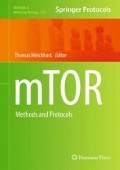Abstract
The adaptive response to hypoxia, low oxygen tension, involves inhibition of energy-intensive cellular processes including protein translation. This effect is mediated in part through a decrease in the kinase activity of mammalian target of rapamycin complex 1 (mTORC1), a master regulator of protein translation. The principle mechanism for hypoxia-induced mTORC1 inhibition, however, was not elucidated until recently. Our work has demonstrated that the stress-induced protein REDD1 is essential for hypoxia regulation of mTORC1 activity and has further defined the molecular mechanism whereby REDD1 represses mTORC1 activity under hypoxic stress. Using our studies with REDD1 as an example, we describe in detail biochemical approaches to assess mTORC1 activity in the hypoxic response. Here, we provide methodologies to monitor signaling components both downstream and upstream of the hypoxia-induced mTORC1 inhibitory pathway. These methodologies will serve as valuable tools for researchers seeking to understand mTORC1 dysregulation in the context of hypoxic stress.
Access this chapter
Tax calculation will be finalised at checkout
Purchases are for personal use only
References
Liu L, Cash TP, Jones RG, Keith B, Thompson CB, and Simon MC (2006) Hypoxia-induced energy stress regulates mRNA translation and cell growth. Mol Cell 21: 521–531
Wouters BG, van den Beucken T, Magagnin MG, Koritzinsky M, Fels D, and Koumenis C (2005) Control of the hypoxic response through regulation of mRNA translation. Semin Cell Dev Biol 16: 487–501
Hochachka PW, Buck LT, Doll CJ and Land SC (1996) Unifying theory of hypoxia tolerance: molecular/metabolic defense and rescue mechanisms for surviving oxygen lack. Proc Natl Acad Sci 93: 9493–9498
Arsham AM, Howell JJ, and Simon MC (2003) A novel hypoxia-inducible factor-independent hypoxic response regulating mammalian target of rapamycin and its targets. J Biol Chem 278: 29655–29660
Koritzinsky M, Magagnin MG, van den Beucken T, Seigneuric R, Savelkouls K, Dostie J, Pyronnet S, Kaufman RJ, Weppler SA, Voncken JW, Lambin P, Koumenis C, Sonenberg N, and Wouters BG (2006) Gene expression during acute and prolonged hypoxia is regulated by distinct mechanisms of translational control. EMBO J 25:1114–1125
Foster KG and Fingar DC (2010) Mammalian target of rapamycin (mTOR): conducting the cellular signaling symphony. J Biol Chem 285: 14071–14077
Ma XM, and Blenis J (2009) Molecular mechanisms of mTOR-mediated translational control. Nat Rev Mol Cell Biol 10: 307–318
Mamane Y, Petroulakis E, LeBacquer O, and Sonenberg N (2006) mTOR, translation initiation and cancer. Oncogene 25: 6416–6422
Burnett PE, Barrow RK, Cohen NA, Snyder SH, and Sabatini DM (1998) RAFT1 phosphorylation of the translational regulators p70 S6 kinase and 4E-BP1. Proc Natl Acad Sci 95: 1432–1437
Gingras AC, Raught B, Gygi SP, Niedzwiecka A, Miron M, Burley SK, Polakiewicz RD, Wyslouch-Cieszynska A, Aebersold R, and Sonenberg N (2001). Hierarchical phosphorylation of the translation inhibitor 4E-BP1. Genes Dev 15:2852–2864
Connolly E, Braunstein S, Formenti S, and Schneider RJ (2006) Hypoxia inhibits protein synthesis through a 4E-BP1 and elongation factor 2 kinase pathway controlled by mTOR and uncoupled in breast cancer cells. Mol Cell Biol 26: 3955–3965
Shoshani T, Faerman A, Mett I, Zelin E, Tenne T, Gorodin S, Moshel Y, Elbaz S, Budanova A, Chajut A, Kalinski H, Kamer I, Rozen A, Mor O, Keshet E, Leshkowitz D, Einat P, Skaliter R, and Feinstein E (2002) Identification of a novel hypoxia-inducible factor 1-responsive gene, RTP801, involved in apoptosis. Mol Cell Biol 22: 2283–2293
Brugarolas J, Lei K, Hurley RL, Manning BD, Reiling JH, Hafen E, Witters LA, Ellisen LW, and Kaelin WG Jr (2004) Regulation of mTOR function in response to hypoxia by REDD1 and the TSC1/TSC2 tumor suppressor complex. Genes Dev 18: 2893–2904
Reiling JH and Hafen E (2004) The hypoxia-induced paralogs Scylla and Charybdis inhibit growth by down-regulating S6K activity upstream of TSC in Drosophila. Genes Dev 18: 2879–2892
Cai SL, Tee AR, Short JD, Bergeron JM, Kim J, Shen J, Guo R, Johnson CL, Kiguchi K, and Walker CL (2006) Activity of TSC2 is inhibited by AKT-mediated phosphorylation and membrane partitioning. J Cell Biol 173: 279–289
DeYoung MP, Horak P, Sofer A, Sgroi D, and Ellisen LW (2008) Hypoxia regulates TSC1/2-mTOR signaling and tumor suppression through REDD1-mediated 14-3-3 shuttling. Genes Dev 22: 239–251
Guertin DA and Sabatini DM (2007) Defining the role of mTOR in cancer. Cancer Cell 12: 9–22
Schneider A, Younis RH, and Gutkind JS (2008) Hypoxia-induced energy stress inhibits the mTOR pathway by activating an AMPK/REDD1 signaling axis in head and neck squamous cell carcinoma. Neoplasia 10: 1295–1302
Sofer A, Lei K, Johannessen CM, and Ellisen LW (2005) Regulation of mTOR and cell growth in response to energy stress by REDD1. Mol Cell Biol 25: 5834–5845
Acknowledgments
The authors would like to thank Nicole Forster and Zachary M. Nash for critical reading of the manuscript and for discussion. This work was funded by RO1 CA122589 to LWE and by NRSA postdoctoral fellowship award F32 CA150633 to DDV.
Author information
Authors and Affiliations
Corresponding author
Editor information
Editors and Affiliations
Rights and permissions
Copyright information
© 2012 Springer Science+Business Media, LLC
About this protocol
Cite this protocol
Vadysirisack, D.D., Ellisen, L.W. (2012). mTOR Activity Under Hypoxia. In: Weichhart, T. (eds) mTOR. Methods in Molecular Biology, vol 821. Humana Press. https://doi.org/10.1007/978-1-61779-430-8_4
Download citation
DOI: https://doi.org/10.1007/978-1-61779-430-8_4
Published:
Publisher Name: Humana Press
Print ISBN: 978-1-61779-429-2
Online ISBN: 978-1-61779-430-8
eBook Packages: Springer Protocols

